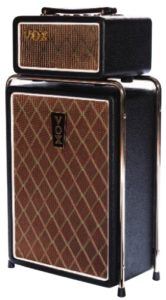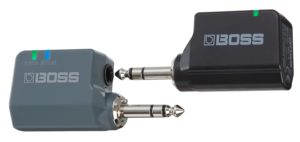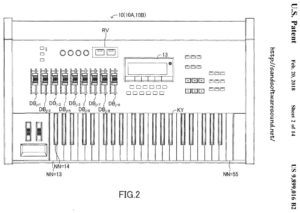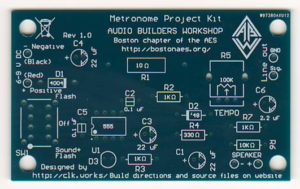I hope my recent post about single coil and double coil guitar tone and amp simulators was helpful. Today, I want to further reduce theory to practice.
A quick recap
Guitar pickups are important to overall guitar tone. There are two main types of pickup: single coil and double coil. Players generally describe the sound of a single coil pickup as bright or thin and describe the sound of a double coil pickup as warm or heavy. Double coil pickups are also called “humbuckers” because the design mitigates pickup noise and hum. Pickup tone tends to favor certain styles of music:
- Single coil: Blues, funk, soul, pop, surf, light rock and country styles
- Double coil (Humbucker): Hard rock, metal, punk, blues and jazz styles
Of course, there are no hard and fast rules and exceptions abound!
Fender guitars frequently use single coil pickups while Gibson favors double coil. Three guitar models are favorites and are in wide use:
- Fender Telecaster (Usually 2 single coil pick-ups): Bright, banjo-like tone, twangy.
- Fender Stratocaster (3 single coil pick-ups): Bright, cutting tone.
- Gibson Les Paul (2 humbucker, dual coil pick-ups) Warm tone with sustain.
The Telecaster was originally developed in 1951 for country swing music. It was quickly adopted by early rock and rollers. The Stratocaster appeared in 1954, but is usually associated with 60s rock. It is often used in rock, blues, soul, surf and country music. The darker tone and sustain of the Les Paul make it suitable for hard rock, metal, blues and jazz styles.
These aren’t the only (in)famous guitars around. The Rickenbacker solid and semi-acoustic models are also classic. Think about the chime-y Beatles and Byrds radio hits from the 1960s. Single coil Ricks are not uncommon.
If you would like to hear the difference in raw tone between Fender Telecaster (single coil), Fender Stratocaster (single coil) and Gibson Les Paul (double coil humbucker), cruise over to this comparison video. The demonstrator compares raw tone starting at roughly 7 minutes into the video, ending at about 11 minutes. The first part of the video is the usual yacking and the last part of the video puts the guitars through an overdrive effect with the demonstrator playing over a backing track. The last part is less informative because our ears need to sort out the guitar from the backing track. Plus, once you put a guitar into a distortion effect, all bets are off. Are you hearing the true guitar tone or just an effected, synthesized tone?
Method to the madness
My ultimate goal is to identify and classify synth and arranger guitar voices, single coil vs. double coil, in order to quickly chose an appropriate guitar voice (patch) for MIDI sequencing. I work with Yamaha gear (Genos workstation, PSR-S950 arranger, and MOX6 synthesizer), so the following discussion will focus on Yamaha. However, you should be able to apply the same method (and guesswork about names!) to Korg, Nord, whoever.
Yamaha provides some major clues as to the origin of its guitar samples, but they are quite reticent to use brand names. Arranger (Genos and S950) voice names are especially opaque. Therefore, the best we can do is to use the clues when possible and to always, always use our ears.
Fortunately, the deep voice editing of the MOX6 lets me dive into the guts of a guitar patch to find the base waveform information including waveform name. In order to get the analysis started, I went into the Mega Voice patches to find the underlying waveforms. When Yamaha sample a guitar, they sample multiple articulations (open string, slap, slide, hammer on, etc.). The waveforms for a particular instrument are a family and share the same root name like “60s Clean.” Given the base waveforms, I then can identify regular synth voices which use the same waveforms. The regular voices are more easily played on the keyboard than Mega Voices, making it easier to perform A/B testing.
Mega Voices are a good entry point for analysis because the MOX, Motif and Montage family have roughly equivalent Mega Voices as the S950, Tyros and Genos product family. This allows A/B testing across and within product lines.
Development history is important, too. I took note of new Mega Voices added to each product generation. Each new Mega Voice is a new waveform family. Given a Mega Voice, I look for new Super Articulation (SArt) voices which were also added at the same time and try to find the SArt voices which are based on the Mega Voice. The chosen SArt voices become reference sounds for further A/B testing and starting points for voice selection when sequencing a song.
When A/B testing, all EQ, filter and DSP effects (including reverb and chorus) must be turned OFF. We need to reveal the sound of the underlying raw waveforms (samples). Even so, there may still be sonic differences due to VCF and VCA programming. I found that this kind of critical listening is quite tiring and it’s better to work for 30 minutes, walk away and come back later with fresh ears. Otherwise, everything starts to sound the same!
Breakdown
Enough faffing around, get to the bottom line.
First up is a correspondence table between Montage (Motif, MOX) Mega Voice guiters and Genos (Tyros, PSR S-series) Mega Voice guitars.
Genos name Motif/MOX name Motif/MOX waveform
--------------------------- -------------------- ------------------
8 10 4 60sVintage n/a [Strat]
8 11 4 60sVintageSlap n/a [Strat]
8 4 4 50sVintageFinger TC Cln Fing *
8 5 4 50sVintageFingerSlap TC Cln Fing Slap
8 6 4 50sVintagePick TC Cln Pick *
8 7 4 50sVintageSlap TC Cln Pick Slap
8 8 4 SlapAmpGuitar
8 3 4 SingleCoilGuitar Mega 1coil Old R&R 1Coil *
8 1 4 SolidGuitar1 Mega 60s * 60s Clean *
8 2 4 SolidGuitar2 Mega 60s * 60s Clean *
8 0 4 CleanGuitar Mega 1coil * Clean *
8 0 7 JazzGuitar Mega Jazz Guitar Jazz *
8 0 5 OverdriveGuitar Mega Ovdr Fuzz Overdrive *
8 0 6 DistortionGuitar Mega Ovdr Distortion Distortion *
A star (“*”) in the table is a placeholder for all of the voices and variants within a family. Motif/MOX have many variants of “Mega 60s” and “Mega 1coil” voices. They all use the “60s Clean” and “Clean” waveforms in different ways, including different stomp box and amplifier effects. A star in the waveform column denotes a waveform family, i.e., collectively a group of waveforms for all of the articulations sampled from the same instrument.
A few observations. Montage did not add any new guitar Mega Voices. Montage does not have a Stratocaster waveform. [A future upgrade for Montage?] Finally, I couldn’t quite work out where “SlapAmpGuitar” fit into the voice universe.
“Slap,” by the way, is a playing technique borrowed from bass players. The thumb hits a string instead of a pick or finger. Usually the lowest string is slapped because it is the most easily hit by the thumb. The slap may be combined with palm or finger muting to prevent other notes/strings from sounding with the slap.
Beyond Mega Voice
Folks know by now that Mega Voices are for styles and arpeggios. Yamaha never intended them to be played using the keyboard. It’s darn near impossible to play with the kind of precision required to trigger the appropriate articulation (waveform) when needed. They’re good for sequencing (styles, arpeggios) because a sequence can be edited in a DAW with precise control over note velocities.
None the less, musicians wanted to be able to play these great sounding voices and Yamaha responded with Expanded Articulation (Motif XS and later) and Super Articulation (Tyros 2 and later). I won’t dive into Expanded Articulation here. Super Articulation, however, effectively puts a software script in front of a Mega Voice. The script translates each player gesture to one of the several articulation waveforms which comprise a Mega Voice.
This description is notional. I doubt if the software uses an actual Mega Voice as the target. Some gestures like legato technique are handled in the AWM2 engine à la Expanded Articulation.
If you followed my suggestion to audition the Mega Voices without EQ, effects, etc., then you surely know how difficult it is to play a Mega Voice from the keyboard. Should you try this, I recommend setting the touch curve to HARD in order to hit those ultra low key velocities. Or, set RIGHT1, RIGHT2 and RIGHT3 to a fixed velocity. By changing the velocity level, you’ll be able to play a specific waveform within a Mega Voice precisely and reliably. Please refer to the Mega Voice maps in the Data List file to see the correspondence between velocity levels and waveforms.
To audition without Mega Voice and to select Genos (Tyros, S950) voices for sequencing, it’s far easier and fun to play a Super Articulation (SArt) voice. Problem is, with Yamaha’s opaque voice naming, it’s difficult to know the exact waveform family you’re triggering. So, I built a table of SArt reference voices by matching SA voices with their Mega Voice equivalent.
Genos Mega Voice SArt reference Waveform
-------------------- --------------- ------------------------
60sVintage 60sVintageClean [Strat]
60sVintageSlap TBD [Strat]
50sVintageFinger CleanFingers TC Cln Fing *
50sVintageFingerSlap FingerSlapSlide TC Cln Fing Slap
50sVintagePick VintageWarm TC Cln Pick *
50sVintageSlap TBD TC Cln Pick Slap
SlapAmpGuitar TBD TC Cln Fing Slap Amp/Lin
SingleCoilGuitar SingleCoilClean 1Coil *
SolidGuitar1 WarmSolid 60s Clean *
SolidGuitar2 WarmSoild 60s Clean *
CleanGuitar CleanSolid Clean *
JazzGuitar JazzClean Jazz *
OverdriveGuitar TBD Overdrive *
DistortionGuitar HeavyRockGuitar Distortion *
Single coil vs. double coil? That’s easy. The only double coil guitars are SolidGuitar1, SolidGuitar2, and any SArt voice built on the 60s Clean waveform. All other guitars are single coil.
Hmmm. I’ll bet that a double coil Gibson Les Paul and/or Gibson SG are in the works. Yamaha will eventually fill the gap!
A few entries in the table are TBD, “to be determined.” Definitively identifying slap guitar has eluded me so far. I can hear a difference between non-slap and slap, but finger slap vs. picked slap, my ears aren’t there yet.
All in all, it was a useful exercise to strip away the effects and EQ. It reminds me of the scene in the documentary “It Might Get Loud” in which The Edge demonstrates his effects pedal board. First, the plain tone of the guitar, then the huge sound with all of the effects piled on. Thanks to the tech built into our keyboards, we can be a little bit like The Edge.
Copyright © 2018 Paul J. Drongowski




